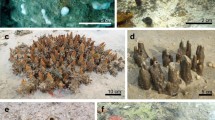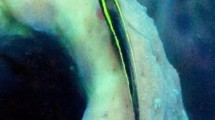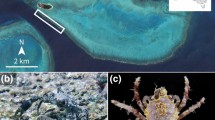Abstract
Cryptic organisms often associate with sessile invertebrates for refuge in space-limited environments. To examine interspecific habitat associations on coral reefs, tube- and vase-shaped sponges were surveyed for associated brittlestars at six sites on the coral reefs off Key Largo, Florida. Of 179 sponges encountered, Callyspongia vaginalis was the most abundant (43.0%), followed by Niphates digitalis (39.7%), and Callyspongia plicifera (4.5%). Three of eight sponge species surveyed did not differ from C. vaginalis in two physical refuge characteristics: oscular diameter and inner tube surface area. Brittlestars (416 total), all of the genus Ophiothrix, were only found in C. vaginalis, N. digitalis, and C. plicifera. The most abundant brittlestar, O. lineata (326), occurred on C. vaginalis (99.0%) and N. digitalis (1.0%), while O. suensonii (67) occurred on C. vaginalis (79.1%), N. digitalis (19.4%), and C. plicifera (1.5%). There was no pattern of co-occurrence of O. lineata and O. suensonii on C. vaginalis. The abundance of O. lineata increased with surface area of C. vaginalis. Differential habitat use was observed in O. lineata, with small individuals (<5 mm disk diameter) located inside and on the surface of sponge tubes and large individuals (≥5 mm) solely inside tubes. The number of large O. lineata in C. vaginalis never exceeded the number of tubes per sponge, and tagged O. lineata remained in the same sponge for at least 3 weeks. In density manipulations, no pattern of intraspecific competition among large O. lineata was observed; however, there was evidence for interaction between size-classes. Brittlestars selected live sponge habitat over a non-living refuge, suggesting a mechanism for sponge habitat recognition. Sponge-dwelling brittle stars prefer some tube- and vase-shaped sponge species despite similar oscular diameters and surface areas. Surprisingly, these preferred sponge species are known from previous studies to be chemically undefended against generalist fish predators; therefore, brittlestars that inhabit these sponges do not gain an associational chemical defense. Sponge habitat use by O. lineata may be governed by intraspecific interactions to maintain habitat and access to food. While past studies have suggested that O. lineata is an obligate sponge commensal, the present study suggests that O. lineata has a species-specific association with the tube-sponge C. vaginalis.










Similar content being viewed by others
References
Aronson R (1988) Palatability of five Caribbean ophiuroids. Bull Mar Sci 43:93–97
Beck MW (1995) Size specific shelter limitation in stone crabs: a test of the demographic bottleneck hypothesis. Ecology 76:968–980
Caddy JF (1986) Modeling stock-recruitment processes in Crustacea: some practical and theoretical perspectives. Can J Fish Aquat Sci 43:2330–2344
Caddy JF, Stamatopoulos C (1990) Mapping growth and mortality rates of crevice dwelling organisms onto a perforated surface: the relevance of ‘cover’ to the carrying capacity of natural and artificial habitats. Estuar Coast Shelf Sci 31:87–106
Clark AH (1939) Echinoderms of the Smithsonian–Hartford Expedition, 1937, with other West Indian records. Proc US Natl Mus 86:441–56
Clark HL (1933) A handbook of the littoral echinoderms of Puerto Rico and the other West Indian islands. Sci Surv Puerto Rico Virgin Is NY Acad Sci 16:1–147
Cronin G, Hay ME, Fenical W, Lindquist N (1995) Distribution, density, and sequestration of host chemical defenses by the specialist nudibranch Tritonia hamnerorum found at high densities on the sea fan Gorgonia ventalina. Mar Ecol Prog Ser 119:177–189
Devaney D (1974) Shallow water echinoderms from British Honduras, with a description of new species of Ophiocoma (Ophiuroidea). Bull Mar Sci 24:122–124
Duarte LF, Nalesso C (1996) The sponge Zygomycale parishii (Bowerbank) and its endobiotic fauna. Estuar Coast Shelf Sci 42:139–151
Duffy JE (1992) Host use patterns and demography in a guild of tropical sponge dwelling shrimps. Mar Ecol Prog Ser 90:127–138
Duffy JE (1996) Species boundaries, specialization, and the radiation of sponge-dwelling alpheid shrimp. Biol J Linn Soc 58:307–324
Duffy JE, Hay ME (1994) Herbivore resistance to seaweed chemical defense: the roles of mobility and predation risk. Ecology 75:1304–1319
Edgar GJ (1983) The ecology of south-east Tasmanian phytal communities. IV. Factors affecting the distribution of amphithoid amphipods among algae. J Exp Mar Biol Ecol 70:181–203
Eggleston D, Lipcius R, Miller D, Coba-Cetina L (1990) Shelter scaling regulates survival of juvenile Caribbean spiny lobster Panulirus argus. Mar Ecol Prog Ser 62:79–88
Fedra K, Olscher EM, Scherubel C, Stachowitsch M, Wurzian RS (1976) On the ecology of the North Adriatic benthic community: distribution, standing crop, and composition of the macrobenthos. Mar Biol 38:129–145
Fretwell SD, Lucas Jr HL (1970) On territorial behavior and other factors influencing habitat distribution in birds. I. Theoretical development. Acta Biotechnol 19:16–36
Gause GF (1934) The struggle for existence. Hafner, New York
Gerrodette T, Flechsig AO (1979) Sediment-induced reduction in the pumping rate of the tropical sponge Verongia lacunosa. Mar Biol 55:103–110
Hacker S, Steneck R (1990) Habitat architecture and the abundance and body-size-dependent habitat selection of a phytal amphipod. Ecology 71:2269–2285
Hay ME (1991) Marine–terrestrial contrasts in the ecology of plant chemical defenses against herbivores. Trends Ecol Evol 6:57–78
Hay ME, Duffy JE, Pfister CA, Fenical W (1987) Chemical defense against different marine herbivores: are amphipods insect equivalents? Ecology 68:1567–1580
Heck Jr KL, Wetstone GS (1977) Habitat complexity and invertebrate species richness and abundance in tropical seagrass meadows. J Biogeogr 4:135–142
Hendler G (1984) The association of Ophiothrix lineata and Callyspongia vaginalis: a brittlestar–sponge cleaning symbiosis? Mar Ecol 5:9–27
Hendler G, Miller JE, Pawson DL, Kier PM (1995) Sea stars, sea urchins, and allies: echinoderms of Florida and the Caribbean. Smithsonian Institution Press, Washington, D.C., USA
Holbrook SJ (1979) Habitat utilization, competitive interactions, and coexistence of three species of cricetine rodents in east-central Arizona. Ecology 60:758–769
Holmes RT, Bonney Jr RE, Pacala SW (1979) Guild structure of the Hubbard Brook bird community: a multivariate approach. Ecology 60:512–520
Huffaker CB (1958) Experimental studies on predation: dispersion factors and predator–prey oscillations. Hilgardia 27:343–383
Kissling D, Taylor G (1977) Habitat factors for reef dwelling ophiuroids in the Florida Keys. In: Taylor DL (ed) Proc 3rd Int Coral Reef Symp, vol 1. University of Miami, Miami, Fla., pp 225–231
MacArthur RH (1958) Population ecology of some warblers of northeastern coniferous forests. Ecology 39:599–619
McGovern T (2002) Sex-ratio bias and clonal reproduction in the brittle star Ophiactis savignyi. Evolution 56:511–517
Pawlik JR (1983) A sponge-eating worm from Bermuda: Branchiosyllis oculata (Polychaeta, Syllidae). Mar Ecol 4:65–79
Pawlik JR (1997) Fish predation on Caribbean reef sponges: an emerging perspective of chemical defenses. In: Lessios HA, MacIntyre IG (eds) Proc 8th Int Coral Reef Symp, vol 2. Smithsonian Tropical Research Institute, Balboa, Panama, pp 1255–1258
Pawlik JR, Chanas B, Toonen RJ, Fenical W (1995) Defenses of Caribbean sponges against predatory reef fish. I. Chemical deterrency. Mar Ecol Prog Ser 127:183–194
Pearse AS (1950) Notes on the inhabitants of certain sponges at Bimini. Ecology 31:150–151
Randall JE (1963) An analysis of the fish populations of artificial reefs in the Virgin Islands. Caribb J Sci 3:31–47
Randall JE (1967) Food habits of reef fishes of the West Indies. Stud Trop Oceanogr 5:665–847
Randall JE, Hartman WD (1968) Food habits of reef fishes of the West Indies. Mar Biol 1:216–225
Roughgarden J (1975) Evolution of marine symbiosis—a simple cost–benefit model. Ecology 56:1201–1208
Rützler K (1976) Ecology of Tunisian commercial sponges. Tethys 7:249–264
Sale PF (1975) Patterns of use of space in a guild of territorial fishes. Mar Biol 29:89–97
Schoppe S (1996) Ophiothrix synoecina: new species (Echinodermata: Ophiuroidea) from the Caribbean coast of Columbia. Bull Mar Sci 58:429–437
Sloan NA (1982) Size and structure of echinoderm populations associated with different coexisting coral species at Aldabra Atoll, Seychelles. Mar Biol 66:67–75
Sokal RR, Rohlf FJ (1981) Biometry, 2nd edn. Freeman, San Francisco, Calif., USA
Stinson CSA, Brown VK (1983) Seasonal changes in the architecture of natural plant communities and its relevance to insect herbivores. Oecologia (Berl) 56:67–69
Targett NM, Schmahl GP (1984) Chemical ecology and distribution of sponges in the Salt River Canyon, St. Croix, U.S.V.I. NOAA Tech Mem OAR NURP-1
Turon X, Codina M, Tarjuelo I, Uriz MJ, Becerro MA (2000) Mass recruitment of Ophiothrix fragilis (Ophiuroidea) on sponges: settlement patterns and post-settlement dynamics. Mar Ecol Prog Ser 200:201–212
Tyler JC, Böhlke JE (1972) Records of sponge-dwelling fishes, primarily of the Caribbean. Bull Mar Sci 22:601–642
Westinga E, Hoetjes PC (1981) The intrasponge fauna of Spheciospongia vesparia (Porifera: Desmospongiae) at Curacao and Bonaire. Mar Biol 62:139–150
Zar JH (1984) Biostatistical analysis, 2nd edn. Prentice-Hall, Englewood Cliffs, N.J., USA
Acknowledgements
We thank G. McFall, S. Engel and W. O’Neal for their assistance in the laboratory and the field. Thanks also to T. McGovern for help with tagging methods. This research was made possible by grants from the NOAA/National Undersea Research Center at UNCW (NA 96RU-0260) and from the National Science Foundation, Biological Oceanography Program (OCE-9711255, OCE-0095724).
Author information
Authors and Affiliations
Corresponding author
Additional information
Communicated by O. Kinne, Oldendorf/Luhe
Rights and permissions
About this article
Cite this article
Henkel, T.P., Pawlik, J.R. Habitat use by sponge-dwelling brittlestars. Marine Biology 146, 301–313 (2005). https://doi.org/10.1007/s00227-004-1448-x
Received:
Accepted:
Published:
Issue Date:
DOI: https://doi.org/10.1007/s00227-004-1448-x




